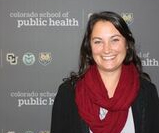For a long time, Liz Young was doing public health without realizing it. Teaching high school students about nutrition and healthy relationships, training kids in bike repair, helping underserved populations access reliable transportation – all are facets of public health in action.
“I didn’t realize I was looking at, for example, social determinants of health,” she explained. “I didn’t have those words.”
When she began her MPH studies at the Colorado School of Public Health at CSU, however, her experience aligned with the vocabulary and concepts of public health practice. And because she chose to pursue a dual degree program including an MPH and a Master of Urban and Regional Planning (MURP) – earning the latter degree from the University of Colorado – Denver – her experience dovetailed with the theories and approaches she was learning in her courses.
Now Liz, who will graduate in May in the Physical Activity and Healthy Lifestyles concentration, is using both her experience and education in her full-time role as the built environment planner for the Larimer County Department of Health and Environment. As a member of a four-person, grant-funded built environment program, she is part of a team whose mission is to promote health equity in plans and policies.
“Even the term ‘built environment’ is still really jargon-y,” she said. “We explain it as our physical environment that we create; everything that’s not natural. What we’re trying to do is get underrepresented voices to participate in the civic engagement process of creating that built environment.”
Winding path to the built environment
It was a circuitous path, though, that brought her to her current understanding of the built environment. While completing her undergraduate education in family and consumer science education and business management at CSU, she focused on pursuing a career in education. She taught high school food science and teen choices classes in Loveland, then segued into AmeriCorps VISTA, running a secular bike refurbishing program hosted by a Christian organization in Greeley.
Through the bike refurbishing program, she began working with immigrant populations and learned that simply matching people with the appropriate bike wasn’t enough.
“There were missing pieces,” she said. “At first we weren’t giving out helmets and locks. And then we thought, OK, repair kits, but you’re never going to find bike repair sheets written in Somali. So, we found some that were more illustrative, and then we worked on maps. But even that wasn’t getting at the root issue, which is that people can’t safely get to where they need to go.”
She said that her involvement in the bike community and issues of active transport helped her recognize her interest in going up a level and working on the policies that shape what she came to learn is the built environment.
“For example, one of the big issues is, we make a program for people to be healthy at the park,” she explained. “But what if they don’t have a park in their neighborhood? What if they can’t safely get to the park? I want to be a person who makes the decision that there’s going to be a park.”
In her position as built environment planner, she is working on projects that range from mapping to partnership building to biking and transit surveys. She said she sees her role, in part, as bridging public and private stakeholders that often can operate in silos and leveraging public health resources.
She said learning the vocabulary and concepts of public health as she pursued her MPH has helped her to “engage with people without being harmful,” she said. “That’s something that the field of public health does very intentionally and very well. We’re figuring out how to build capacity and promote health.”

